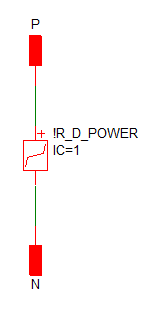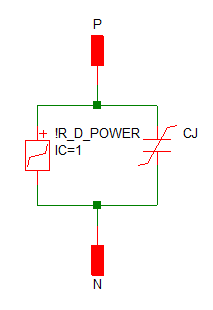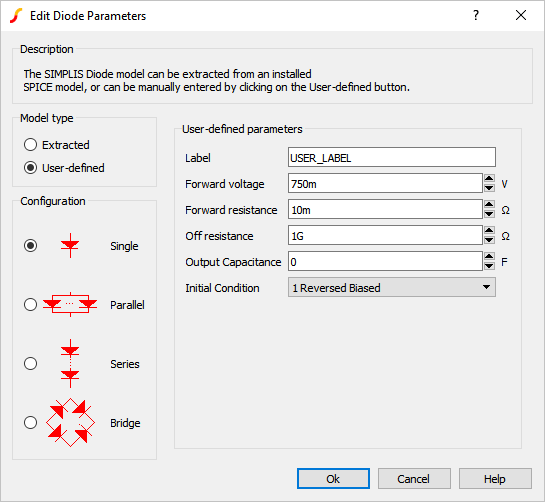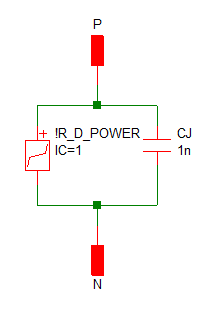SIMPLIS Diode Models
Any SPICE diode model installed in the SIMetrix library can be converted for use in SIMPLIS. When a diode is placed on a SIMPLIS schematic, a model parameter extraction routine is invoked to automatically convert the SPICE model to a SIMPLIS model. During the model parameter extraction process, SIMetrix/SIMPLIS automatically runs several SPICE simulations on the SPICE model and extracts the SIMPLIS model parameters. After the Piecewise Linear (PWL) model parameters have been extracted, the resulting diode model will run in SIMPLIS. Any installed SPICE diode model can be used in SIMPLIS.
The extracted diode model can then be used to create a model for one of four diode configurations:
| Configuration | Description | Additional Parameter |
| Single | A single diode | none |
| Parallel | Multiple diodes in parallel | Number of parallel diodes |
| Series | Multiple diodes in series | Number of series diodes |
| Bridge | Four diodes in a bridge configuration | Bridge imbalance voltage |
These diode configurations are more than a convenience, SIMPLIS will run faster with these models, and run into less problems with errors.
In this topic:
Extracting the Diode Parameters
When you place a Diode symbol on a schematic, the Extract Diode Parameters dialog opens for you to edit the default test conditions. The default test conditions are defined using the command shell menu . For additional information, see SIMPLIS Diode Options.

The following table describes the Extract Diode Parameters dialog test conditions.
| Test Condition | Default Value | Units | Description |
| SPICE Model | D1N4148 | The SPICE model used to extract SIMPLIS parameters. | |
| Model type | Extracted | Invokes the model parameter extraction algorithms. |
| Forward current | 200m | A | The peak forward current used for curve fitting. The algorithm fits a straight line between 50% and 100% of this value. |
| Reverse voltage | 100 | V | The peak off-state voltage seen by this device. Used to extract capacitance for model level = 1 which includes parasitic capacitance. Breakdown is not modeled. |
| Model temperature | 50 | °C | Temperature used for all extraction simulations. |
| Model level | 0 | Model complexity. For information on choosing the model level, see SIMPLIS_Diode_Model_Levels. | |
| Number of Segments | 3 | Diodes may have two segments - representing On and Off Resistance or three segments with the third segment representing the transition between the On and Off states. | |
| Initial Condition | 0 Reversed Biased | Sets initial conducting segment. | |
| Limit maximum off resistance | Checked | none | Limits the off resistance for the diode. For some SPICE models, this will produce a SIMPLIS model which runs faster. |
| Maximum off resistance | 100Meg | W | The maximum off resistance of the diode. This value is used only if the "Limit maximum off resistance" checkbox is Checked. |
Show extracted PWL waveforms option
Beginning in version 8.2, there is now an option to plot the extracted parameters as a set of PWL curves. To enable this option, select the Show extracted PWL waveforms checkbox and extract the model. After the model is extracted, a set of curves will be generated comparing the extracted PWL curves against the simulated SPICE curves. The curves displayed will depend on the model level being extracted.
Below is a typical PWL approximation of the Forward Bias Current characteristic of the diode, with the SPICE curve in red and the PWL curve in blue.

SIMPLIS Diode Model Levels
The SIMPLIS Diode models support two levels: 0 and 1.
- Level 0 is a pure conduction diode.
- Level 1 adds the junction capacitance.
SIMPLIS extracts a model based on the model level chosen in the Extract Diode Parameters dialog. Although these models are internally saved as ASCII text, the following illustrations show the two model levels in a schematic form.
Level 0 Model
Level 0 models a diode on/off resistance values only. This Level 0 model can be used for almost every simulation you may encounter in SIMPLIS.
- The diode conduction region is modeled with a 2- or 3-segment resistor.
- There is no junction capacitance in a Level 0 model.
Below is a schematic view of Level 0 model:
| Level 0 models these circuit elements | Level 0 Schematic | ||
|

|
Level 1 Model
Level 1 models a diode with on/off resistance values and a junction capacitance with up to 4 PWL segments.
- The diode conduction region is modeled with a 2- or 3-segment resistor.
- The junctions capacitance is modeled with a variable number of segments, with a maximum of four.
Below is a schematic view of Level 1 model:
| Level 1 models these circuit elements | Level 1 Schematic | ||||
|

|
User-defined Models
The user-defined model uses parameters entered directly in the Edit Diode Parameters dialog without invoking the model extraction algorithms. A Diode can be switched from an extracted model to a user-defined model at any point; however the extracted parameters are by default copied over to the user-defined parameters, replacing any user-entered values. You can disable this behavior in the SIMPLIS Options by clearing the check box labeled Automatically copy extracted parameters to User-defined parameter. You can access these options from the command shell menu . For more information, see SIMPLIS Diode Options.

| Parameters | Default Value | Units | Description |
| Label: | USER_LABEL | ||
| Model type: | User-defined | ||
| Forward voltage: | 750m | V | Diode forward voltage drop. The diode effectively turns on at this voltage. |
| Forward resistance: | 10m | Ω | The diode resistance at voltages higher than the Forward voltage. |
| Off Resistance: | 1G | Ω | The resistance of the diode at voltages less than the Forward voltage. |
| Output Capacitance: | 0 | F | Linear capacitance at the Reverse voltage |
User-defined model
| Models these circuit elements | User-defined Schematic | ||||
|

|
Manually Generate and Customize Diode Models
You can customize or manually generate your own diode models using a parameter string with multiple PARAM_NAME=PARAM_VALUE key-value pairs. The parameter names and their functions are described in the Diode Model Parameters section below. You can interpret the SIMPLIS parameter values from device datasheet specifications and curves.
You can compose the parameter string in a text editor, spreadsheet, or script. The order of the parameter names in the parameter string and the capitalization of the parameter names are irrelevant.
You can include a PROTECTED=1 key-value pair to prevent from extracting a model and overwriting your manually generated parameters. The PROTECTED=1 key-value pair is not used in the simulation.

To customize or generate your own diode model, follow these steps:
- Create a parameter string of multiple PARAM_NAME=PARAM_VALUE key-value pairs using your preferred text editor, spreadsheet or script.
- Add the PROTECTED=1 key-value pair to the parameter string.
- Extract a diode model and place it on a schematic.
- Right click on the symbol and select Edit/Add Properties....
- Double click on the PARAM_VALUES property.Result: The Edit Property dialog opens. At this point, you can change individual parameters in the Value box, or replace the entire default properties with the parameter string that you created in Step 2.
- To replace the entire string, follow these steps:
- Click in the Value box and type Ctrl A to select all of the existing parameter string, and press Delete.
- Copy the parameter string you completed in Step 2 and paste into the Value box.
- Click Ok.
- To change the name of your customized model, double click the VALUE property in the Edit Properties dialog, and change the name in the Value box.
- To return to the schematic, click Ok.
prop PARAM_VALUES parameter_stringwhere parameter_string is the set of key-value pairs that you created in Steps 1 and 2 above.
Diode Model Parameters
The following tables detail the parameters which define the electrical behavior of the Diode model. Several other parameters in the PARAM_VALUES property have no effect on the electrical behavior of the model. These parameters are used to populate the Extract Diode Parameters dialog box.
Conduction Model
Diodes are modeled in SIMPLIS with Piecewise Linear (PWL) resistors. The PWL segments are represented by X,Y points
- The points are defined with the voltage on the X-axis and the current on the Y-axis.
- The resistance is the inverse of the slope of any segment.
- The subscripts on IDx and VDx indicate the point pair location from lowest voltage, i.e. reverse biased, to highest voltage, i.e. forward conduction.
| Parameter Names | Default Value | Description | |
| NUMSEG | 3 | Number of segments in
the diode model.
|
|
| VD0 | ID0 | 1.123456789 | X-Y point definitions
for diode:
|
| VD1 | ID1 | 1.123456789 | |
| VD2 | ID2 | 1.123456789 | |
| VD3 | ID3 | 1.123456789 | |
| VD4 | ID4 | 1.123456789 | |
| VD5 | ID5 | 1.123456789 | |
| VD6 | ID6 | 1.123456789 | |
Capacitor Model
Capacitors are modeled in SIMPLIS with Piece-Wise Linear capacitors.
- The same system of point-pairs is used,but the plane is defined with Voltage on the X-axis and Charge on the X-axis.
- The same system of subscripts is used to define the point pairs.
- VCJ0 and QCJ0 represent the lowest Voltage-Charge pair, with increasing subscripts representing increasing reverse bias.
- On the Voltage-Charge plane, capacitance is the slope of any segment.
| Parameter Names | Default Value | Description | |
| CJ_NSEG | 4 | Number of segments in the Junction capacitor model | |
| VCJ0 | QCJ0 | 1.123456789 | X-Y point definitions
for Junction capacitor:
|
| VCJ1 | QCJ1 | 1.123456789 | |
| VCJ2 | QCJ2 | 1.123456789 | |
| VCJ3 | QCJ3 | 1.123456789 | |
| VCJ4 | QCJ4 | 1.123456789 | |
| VCJ5 | QCJ5 | 1.123456789 | |
| VCJ6 | QCJ6 | 1.123456789 | |
| VCJ7 | QCJ7 | 1.123456789 | |
| VCJ8 | QCJ8 | 1.123456789 | |
| VCJ9 | QCJ9 | 1.123456789 | |
| VCJ10 | QCJ10 | 1.123456789 | |